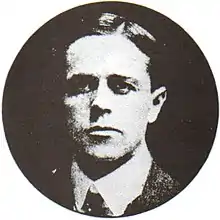The Order of Chaeronea was a secret society for the cultivation of a homosexual moral, ethical, cultural, and spiritual ethos. It was founded by George Cecil Ives in 1897 as a result of his belief that homosexuals would not be accepted openly in society and must therefore have a means of underground communication.[1]
The society is named after the location of the battle where the Sacred Band of Thebes was finally annihilated in 338 BC.[2]
Establishment and organization

In the 1860s, the German lawyer Karl Heinrich Ulrichs may have been the first modern European to publicly declare his homosexuality. Ulrichs wrote dozens of books and pamphlets which argued that the preference for same-sex love is hereditary; therefore it should not be a crime. He introduced the word "Uranian" as a synonym for homosexual relations, and even demanded that homosexuals be granted the right to marry.
Less radical thinkers in Germany, Austria and France began to argue that same-sex attraction and relations between men were a psychological disturbance to be treated by physicians, rather than a crime to be punished by the courts. As a result, by 1876 "psychological" had become a term that Oscar Wilde and his peers used to describe anything pertaining to gay sex.[3] At the same time, McKenna writes, "aestheticism seemed to spring to life, fully formed, towards the end of the 1870s." It was "a heady mix of art, idealism and politics, which sought to propagate a new gospel of Beauty."[4]
In 1893, shortly after meeting Wilde, George Cecil Ives, a friend of Wilde's whose diaries contain many new details of the writer's life, founded a secret society called the Order of Chaeronea, aimed at promoting 'the Cause'.[5] The society was named "after the battle where the male lovers of the Theban Band were slaughtered in 338 BC." Ives and other members dated letters and other materials from the year of the battle, so that 1900 would be written as C.2238.[6]

The 'Rules of Purpose' stated that the Order was to be 'A Religion, A Theory of Life, and Ideal of Duty', although its purpose was primarily political. Members of the Order were 'Brothers of the Faith', and were required to swear under the 'Service of Initiation', that "you will never vex or persecute lovers" and "That all real love shall be to you as sanctuary."[7]
The group was male dominated, but did include a few lesbian members.[5]
At its peak 'the Elect' numbered perhaps two or three hundred, but no membership lists survive. Oscar Wilde was, however, probably an early recruit, along with Lord Alfred Douglas "Bosie".[5] Other members may have included Charles Kains Jackson, Samuel Elsworth Cottam, Montague Summers, and John Gambril Nicholson.
An elaborate system of rituals, ceremonies, a service of initiation, seals, codes, and passwords were established. The Order, according to Ives' notebooks, had a specific purpose, distinct prescriptions and philosophy, and its particular symbolism: the "sign-word" AMRRHAO and "the seal of the double wreath." The prerequisites of membership were indicated to be "Zeal, Learning and Discipline." The principle of secrecy was conveyed by the metaphor of "The Chain" underlining that one should never reveal any information about the order or its members. The writings of Walt Whitman were particularly revered.[8]
Ives was keen to stress that the Order was to be an ascetic movement, not to be used as a forum for men to meet men for sex, although he accepted a degree of 'passionate sensuality' could take place. He also believed that love and sex between men was a way to undermine the rigid class system, as a true form of democracy.[5] The Secret Society became a worldwide organisation,[8] and Ives took advantage of every opportunity to spread the word about the "Cause."
In Ives' words:
We believe in the glory of passion. We believe in the inspiration of emotion. We believe in the holiness of love. Now some in the world without have been asking as to our faith, and mostly we find that we have no answer for them. Scoffers there be, to whom we need not reply, and foolish ones to whom our words would convey no meaning. For what are words? Symbols of kindred comprehended conceptions, and like makes appeal to like.[9]
See also
References
- ↑ Cook, London and the Culture of Homosexuality 1885-1914, Cambridge University Press, 2003, pp.137-40
- ↑ Aldrich, Robert; Wotherspoon, Garry (2002). Who's who in Gay and Lesbian History: From Antiquity to World War II. Psychology Press. ISBN 9780415159838.
- ↑ McKenna, Neil (5 March 2009). The Secret Life of Oscar Wilde. Basic Books. ISBN 9780786734924.
- ↑ Kaiser, Charles (3 July 2005). "Rebel With a Cause". Washington Post. Retrieved 25 August 2019.
- 1 2 3 4 Neil McKenna, The Secret Life of Oscar Wilde, Arrow Books, 2004
- ↑ Crompton, Louis (July 2009). Homosexuality and Civilization. ISBN 9780674030060. Retrieved 25 August 2019.
- ↑ McKenna, Neil (5 March 2009). The Secret Life of Oscar Wilde. Basic Books. ISBN 9780786734924.
- 1 2 Keth Stern, Queers in History: The comprehensive encyclopaedia, BenBella Books, 2009
- ↑ ago, Barry Duke • 2 years (30 January 2018). "Seeing Oscar Wilde through Catholic-tinted specs". The Pink Triangle Trust. Retrieved 25 August 2019.
{{cite web}}: CS1 maint: numeric names: authors list (link)